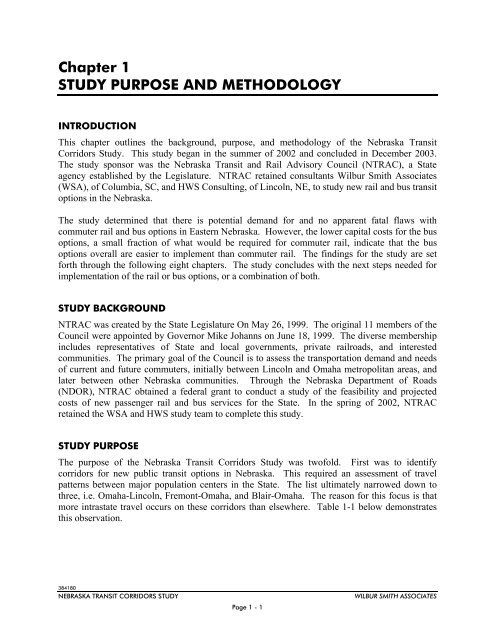NTRAC Final Study - Nebraska Department of Roads - State of ...
NTRAC Final Study - Nebraska Department of Roads - State of ...
NTRAC Final Study - Nebraska Department of Roads - State of ...
You also want an ePaper? Increase the reach of your titles
YUMPU automatically turns print PDFs into web optimized ePapers that Google loves.
Chapter 1<br />
STUDY PURPOSE AND METHODOLOGY<br />
INTRODUCTION<br />
This chapter outlines the background, purpose, and methodology <strong>of</strong> the <strong>Nebraska</strong> Transit<br />
Corridors <strong>Study</strong>. This study began in the summer <strong>of</strong> 2002 and concluded in December 2003.<br />
The study sponsor was the <strong>Nebraska</strong> Transit and Rail Advisory Council (<strong>NTRAC</strong>), a <strong>State</strong><br />
agency established by the Legislature. <strong>NTRAC</strong> retained consultants Wilbur Smith Associates<br />
(WSA), <strong>of</strong> Columbia, SC, and HWS Consulting, <strong>of</strong> Lincoln, NE, to study new rail and bus transit<br />
options in the <strong>Nebraska</strong>.<br />
The study determined that there is potential demand for and no apparent fatal flaws with<br />
commuter rail and bus options in Eastern <strong>Nebraska</strong>. However, the lower capital costs for the bus<br />
options, a small fraction <strong>of</strong> what would be required for commuter rail, indicate that the bus<br />
options overall are easier to implement than commuter rail. The findings for the study are set<br />
forth through the following eight chapters. The study concludes with the next steps needed for<br />
implementation <strong>of</strong> the rail or bus options, or a combination <strong>of</strong> both.<br />
STUDY BACKGROUND<br />
<strong>NTRAC</strong> was created by the <strong>State</strong> Legislature On May 26, 1999. The original 11 members <strong>of</strong> the<br />
Council were appointed by Governor Mike Johanns on June 18, 1999. The diverse membership<br />
includes representatives <strong>of</strong> <strong>State</strong> and local governments, private railroads, and interested<br />
communities. The primary goal <strong>of</strong> the Council is to assess the transportation demand and needs<br />
<strong>of</strong> current and future commuters, initially between Lincoln and Omaha metropolitan areas, and<br />
later between other <strong>Nebraska</strong> communities. Through the <strong>Nebraska</strong> <strong>Department</strong> <strong>of</strong> <strong>Roads</strong><br />
(NDOR), <strong>NTRAC</strong> obtained a federal grant to conduct a study <strong>of</strong> the feasibility and projected<br />
costs <strong>of</strong> new passenger rail and bus services for the <strong>State</strong>. In the spring <strong>of</strong> 2002, <strong>NTRAC</strong><br />
retained the WSA and HWS study team to complete this study.<br />
STUDY PURPOSE<br />
The purpose <strong>of</strong> the <strong>Nebraska</strong> Transit Corridors <strong>Study</strong> was tw<strong>of</strong>old. First was to identify<br />
corridors for new public transit options in <strong>Nebraska</strong>. This required an assessment <strong>of</strong> travel<br />
patterns between major population centers in the <strong>State</strong>. The list ultimately narrowed down to<br />
three, i.e. Omaha-Lincoln, Fremont-Omaha, and Blair-Omaha. The reason for this focus is that<br />
more intrastate travel occurs on these corridors than elsewhere. Table 1-1 below demonstrates<br />
this observation.<br />
384180<br />
NEBRASKA TRANSIT CORRIDORS STUDY<br />
Page 1 - 1<br />
WILBUR SMITH ASSOCIATES

















